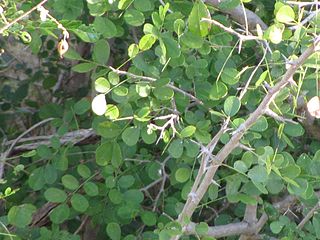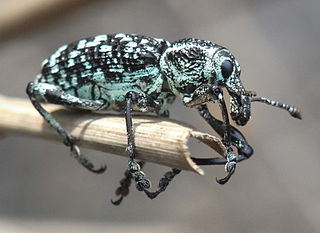
Acacia s.l., known commonly as mimosa, acacia, thorntree or wattle, is a polyphyletic genus of shrubs and trees belonging to the subfamily Mimosoideae of the family Fabaceae. It was described by the Swedish botanist Carl Linnaeus in 1773 based on the African species Acacia nilotica. Many non-Australian species tend to be thorny, whereas the majority of Australian acacias are not. All species are pod-bearing, with sap and leaves often bearing large amounts of tannins and condensed tannins that historically found use as pharmaceuticals and preservatives.

The Fabaceae or Leguminosae, commonly known as the legume, pea, or bean family, are a large and agriculturally important family of flowering plants. It includes trees, shrubs, and perennial or annual herbaceous plants, which are easily recognized by their fruit (legume) and their compound, stipulate leaves. The family is widely distributed, and is the third-largest land plant family in number of species, behind only the Orchidaceae and Asteraceae, with about 765 genera and nearly 20,000 known species.

The Melba Gully State Park was formed to protect a small pocket of natural rainforest in the Otway Ranges near Apollo Bay in Victoria, Australia. The 48-hectare (120-acre) park was extremely valuable as much of the rest of the Ranges has been burnt out many times by bushfires. The park now forms part of the Great Otway National Park.

Acacia koa, commonly known as koa, is a species of flowering tree in the family Fabaceae. It is endemic to the Hawaiian Islands, where it is the second most common tree. The highest populations are on Hawaiʻi, Maui and Oʻahu.

Dalbergia melanoxylon is a flowering plant in the family Fabaceae, native to seasonally dry regions of Africa from Senegal east to Eritrea and south to the north-eastern parts of South Africa. The tree is an important timber species in its native areas; it is used in the manufacture of musical instruments and fine furniture. Populations and genomic resources for genetic biodiversity maintenance in parts of its native range are threatened by overharvesting due to poor or absent conservation planning and by the species' low germination rates.

Rosewood refers to any of a number of richly hued timbers, often brownish with darker veining, but found in many different hues and colours.

Acacia, commonly known as the wattles or acacias, is a large genus of shrubs and trees in the subfamily Mimosoideae of the pea family Fabaceae. Initially, it comprised a group of plant species native to Africa and Australasia. The genus name is New Latin, borrowed from the Greek ἀκακία, a term used by Dioscorides for a preparation extracted from the leaves and fruit pods of Vachellia nilotica, the original type of the genus. In his Pinax (1623), Gaspard Bauhin mentioned the Greek ἀκακία from Dioscorides as the origin of the Latin name.

Blackwood is a south-eastern suburb located in the foothills of Adelaide, South Australia. It is part of the local government area of the City of Mitcham.

Acacia melanoxylon, commonly known as the Australian blackwood, is an Acacia species native in South eastern Australia. The species is also known as blackwood, hickory, mudgerabah, Tasmanian blackwood, or blackwood acacia. The tree belongs to the Plurinerves section of Acacia and is one of the most wide-ranging tree species in eastern Australia and is quite variable mostly in the size and shape of the phyllodes.

Mount Napier in Victoria, Australia, is one of the youngest volcanoes in Australia. It erupted about 32,000 years ago. It was named by Major Thomas Mitchell after the three Napier brothers, who he had served alongside during the Peninsular War. Mitchell named it in August 1836, during his third expedition across south-eastern Australia. The local Aboriginal name for the mount is Tapoc. Mount Napier State Park is located 270 kilometres west of Melbourne and 17 km south of Hamilton.

Chrysolopus spectabilis is a species of weevil found in south-eastern Australia. It was discovered during James Cook's first voyage, and became one of the first insects to be described from Australia. The weevil measures up to 25 mm (1.0 in) long and includes distinctive metallic green and black scales. It is found only on 28 species of the plant genus Acacia.

Black wattle is the common name for a number of species of trees that are native to Australia, as listed below:

Acacia floribunda is a perennial evergreen shrub or tree. It is a species of wattle native to New South Wales, Queensland and Victoria, but is cultivated extensively, and has naturalised in South Australia, Tasmania and Western Australia, and also in Indonesia, Mauritius and northern New Zealand. Common names for it include gossamer wattle, weeping acacia and white sallow wattle. It grows up to 6m in height, but there is a commercial form available which only grows to about 1m tall. Its cream-colored flowers occur in the early Spring.

Acacia heterophylla, the highland tamarind, is a tree endemic to Réunion island where it is commonly named tamarin des hauts The tree has a juvenile stage where its leaves have a pinnate arrangement, but in the adult stage the leaves diminish and the phyllode becomes the dominant photosynthetic structure.

Leucoanthocyanidin (flavan-3,4-diols) are colorless chemical compounds related to anthocyanidins and anthocyanins. Leucoanthocyanins can be found in Anadenanthera peregrina and in several species of Nepenthes including N. burbidgeae, N. muluensis, N. rajah, N. tentaculata, and N. × alisaputrana.

Diplazium molokaiense is a rare species of fern known by the common name Molokai twinsorus fern. It is endemic to Hawaii, where it is one of the rarest ferns. It has historically been found on the islands of Kauai, Oahu, Lanai, Molokai, and Maui, but it is thought to have been extirpated from four of them and today can be found only on Maui where fewer than 70 individual plants remain. The fern was federally listed as an endangered species of the United States in 1994.

Dicranosterna semipunctata is a species of leaf beetle common in NSW and Victoria, . It is a honey brown color, strongly convex and feeds on phyllodes Acacia such as blackwood Acacia melanoxylon. In New Zealand it has become a potential problem for the trees and biological controls have been investigated.

















